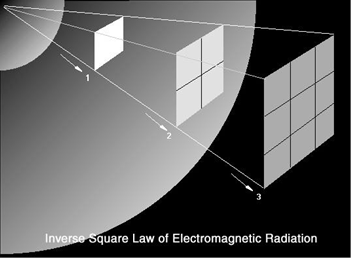
Inverse-Square Law of Propagation
 المؤلف:
Diane Fisher Miller
المؤلف:
Diane Fisher Miller
 المصدر:
Basics of Radio Astronomy
المصدر:
Basics of Radio Astronomy
 الجزء والصفحة:
p11
الجزء والصفحة:
p11
 24-2-2016
24-2-2016
 2588
2588
Inverse-Square Law of Propagation
As electromagnetic radiation leaves its source, it spreads out, traveling in straight lines, as if it were covering the surface of an ever expanding sphere. This area increases proportionally to the square of the distance the radiation has traveled. In other words, the area of this expanding sphere is calculated as 4πR2 , where R is the distance the radiation has travelled, that is, the radius of the expanding sphere. This relationship is known as the inverse-square law of (electromagnetic) propagation. It accounts for loss of signal strength over space, called space loss. For example, Saturn is approximately 10 times farther from the sun than is Earth. (Earth to sun distance is defined as one astronomical unit, AU). By the time the sun’s radiation reaches Saturn, it is spread over 100 times the area it covers at one AU. Thus, Saturn receives only 1/100th the solar energy flux (that is, energy per unit area) that Earth receives.

The inverse-square law is significant to the exploration of the universe. It means that the concentration of electromagnetic radiation decreases very rapidly with increasing distance from the emitter. Whether the emitter is a spacecraft with a low-power transmitter, an extremely powerful star, or a radio galaxy, because of the great distances and the small area that Earth covers on the huge imaginary sphere formed by the radius of the expanding energy, it will deliver only a small amount of energy to a detector on Earth.
 الاكثر قراءة في مواضيع عامة في علم الفلك
الاكثر قراءة في مواضيع عامة في علم الفلك
 اخر الاخبار
اخر الاخبار
اخبار العتبة العباسية المقدسة


